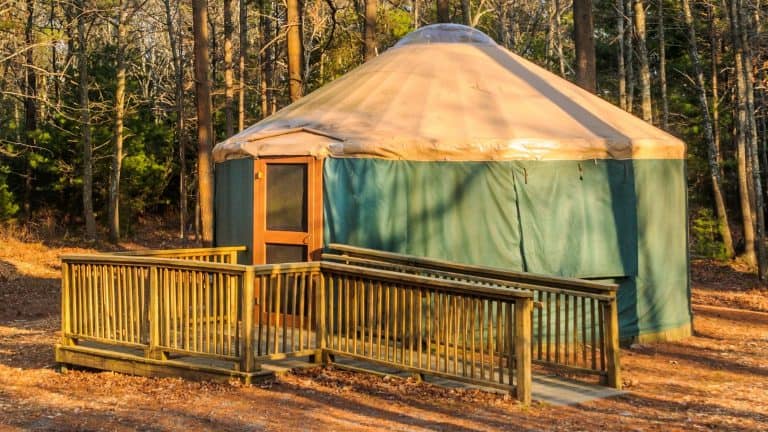Yurt Vs Tiny House: Which Is Better?
Yurts and tiny homes are appealing to those of us who are planning to downsize our homes. They both provide an opportunity to minimize our cost of living significantly, and they require relatively little maintenance.
Perhaps you are reading this because you plan to simplify your life and have come across these two alternative home options. But which is the best choice? Yurts have gained popularity in recent years, and for good reasons, but so have tiny houses.
Yurts are more affordable and much easier to build compared to tiny houses. They can also provide more space than a tiny house. An advantage of tiny houses on wheels is that they can be easily moved, and they will last for a long time with little maintenance, but they also cost more to buy or build.
Let’s go through the relative advantages and disadvantages of yurts and tiny houses. Hopefully, this will help you make an informed decision.
Price of a Tiny House Vs Yurt
The price of any home depends on multiple factors, such as its size and quality of the materials used. This is also the case for tiny houses and yurts.
You can reasonably expect to pay between $12,000 and $30,000 for a medium-to-large yurt (20+ sq. ft.) and a little less for smaller models. The higher end of this price scale is for a big, fully insulated yurt made from quality materials and with lots of attention to detail. You could potentially save some money by building the yurt from scratch, which is rarely done as it is very time-consuming and requires specialized skills.
On the other hand, the price of a tiny house varies much more than that of yurts. If you are a skilled builder and know how to source cheap or free building materials, it could potentially be constructed at almost no cost besides the time it takes to build it. However, a tiny house’s average cost is $30,000 to $60,000, which is much less than a traditional house but a relatively high price per square foot. The price of a new prefabricated tiny house starts at $50,000 and can go to $150,000 or more.
Does Size Matter to You?
There are benefits to owning a small home as they are cheaper to heat and require less maintenance and cleaning. But while downsizing has caught on recently, not every downsizer wishes to live on just a couple of hundred square feet. Some need space for a larger family, hobbies, or business, or they just prefer a little more room for themselves.
Yurts can realistically be up to 706 square feet (30 feet in diameter). Some producers do offer even larger models, although they are less common. The realistic maximum size of a yurt is 50 feet in diameter or 1963 square feet.
A house can be size, and there is some disagreement on what constitutes a tiny house. But according to the International Residential Code, tiny houses are defined as a house with 400 square feet (37 square meters)or less floor space not including lofts. However, tiny homes on wheels are typically about half that size due to the trailer size limitations.
Moving Your Home
While a commonly stated reason to downsize your home is to save money, freedom is much more than just financial freedom. To many of us, freedom is also the ability to pick up and move when we feel the desire or need to do so. This is also one reason why some choose to live in a tiny house or a yurt, as both of these homes can be easy to transport.
A tiny house placed on a trailer provides the most geographic flexibility. Not only can it be hitched to a truck in a few minutes and towed almost anywhere, but you can also park it wherever it is legal to do so. If being able to move your home quickly and easily is a priority, a tiny house on wheels is probably the best option.
Yurts are somewhat more time-demanding to move, and models with glass pane windows and heavy utilities are significantly more difficult to disassemble and transport. On the other hand, a traditional yurt with few modern luxuries is essentially a sturdy tent that can be disassembled and reassembled quickly. But you will have to pack the yurt and all of your stuff during every relocation.
Ease of Build
Yurts are very easy and quick to set up. As mentioned above, a small and simple yurt can be constructed in just a few hours. If you prefer modern conveniences, such as glass windows, or a very large yurt, it will take you a little longer to do, but a yurt is still among the easiest and quickest homes that one can build.
Tiny houses are more difficult and much more time-consuming to build. Building a solid tiny house requires throughout planning, and you will need to have some carpentry skills. If you want the tiny house to be on wheels, you will also have to do some welding in order to safely attach it to a trailer.
Lifespan and Durability
Generally, yurts and tiny homes alike will last quite a long time, and with the necessary maintenance, they should last for many years.
A tiny house, if well-made, can last for decades, but beware that the trailer will not live as long as the house. Consider building the tiny home in a way that it can be easily lifted from its trailer and moved to a new trailer. You should also expect to do the same kinds of maintenance you would do in an ordinary house.
A yurt can also last for many years with little maintenance. However, the yurt exterior consists of a fabric cover that will eventually get damaged and in need of replacement. A quality cover should last about 15 to 20 years, at which point it will need to be replaced. The top dome has a similar lifespan and will likely also require replacement at that same time.
Zoning, Building Codes, and Permits
Zoning and permits can be a huge hassle when building a home – depending on where you live. Is there any benefit to choosing yurts or tiny homes regarding the red tape one will have to go through?
A tiny house on wheels will usually be considered a non-permanent building or an RV. It will have to go through an inspection if you want license plates. But the upside is that you can potentially live in it without worrying too much about building codes, zoning, or permits. Although this is not always the case as it depends on local ordinances, and you may have to build septic and connect to public utilities to live legally in your tiny house.
Yurts also offer similar potential upsides in terms of avoiding excessive red tape. A yurt without foundation is typically considered a tent, which means you may be able to set it up without special permits or building codes. However, this is not always the case and you should check your local regulations. Although there are good reasons, you would want a foundation, as it provides more efficient insulation and protection against rodents.
Beware that you may run into issues with restrictions on minimum size limits if you place a tiny house or yurt and on a foundation. Zoning regulations often require homes have a minimum size of between 500 and 1,000 square feet, which means you may need a very big yurt or a not-so-tiny house.
Should I Get a Tiny House or a Yurt?
Both yurts and tiny homes alike are great downsizing options. They are much more affordable than ordinary houses and faster to construct. But they do appeal to somewhat different sets of preferences.
- Advantages of yurts
- Affordable
- Easy to build
- Potentially more floor space
- Advantages of tiny homes
- Easy to move
- Less maintenance
If you plan to move around a lot, a tiny house is the better option. Having a home that you can easily hitch to a truck makes it a lot easier to move whenever you want to, especially if you want to have modern conveniences such as running water and electricity in your home.
A yurt is great if you plan on settling down in one place for a long time and you want or need a little more space than what a tiny house on wheels can provide. A larger yurt can comfortably house a family with several children. Yurts are also very affordable as you can buy a high-end yurt for the price of a very cheap tiny house.






